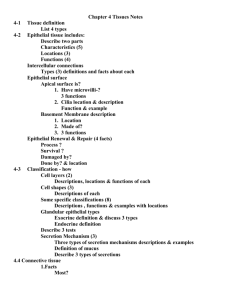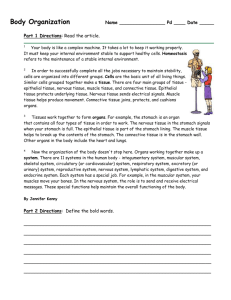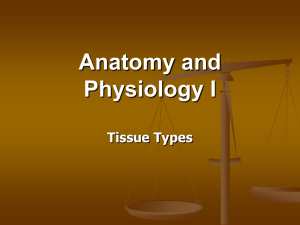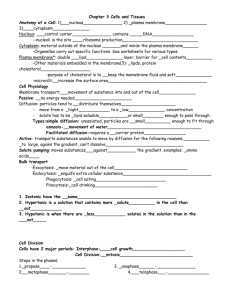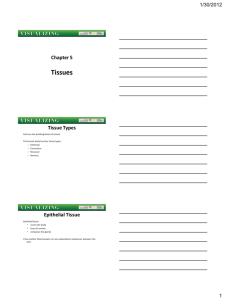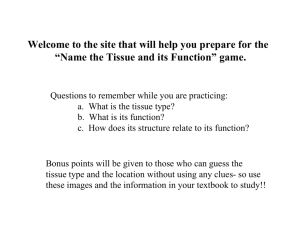HumBio101x Essential Human Biology: Cells & Tissues Syllabus
advertisement
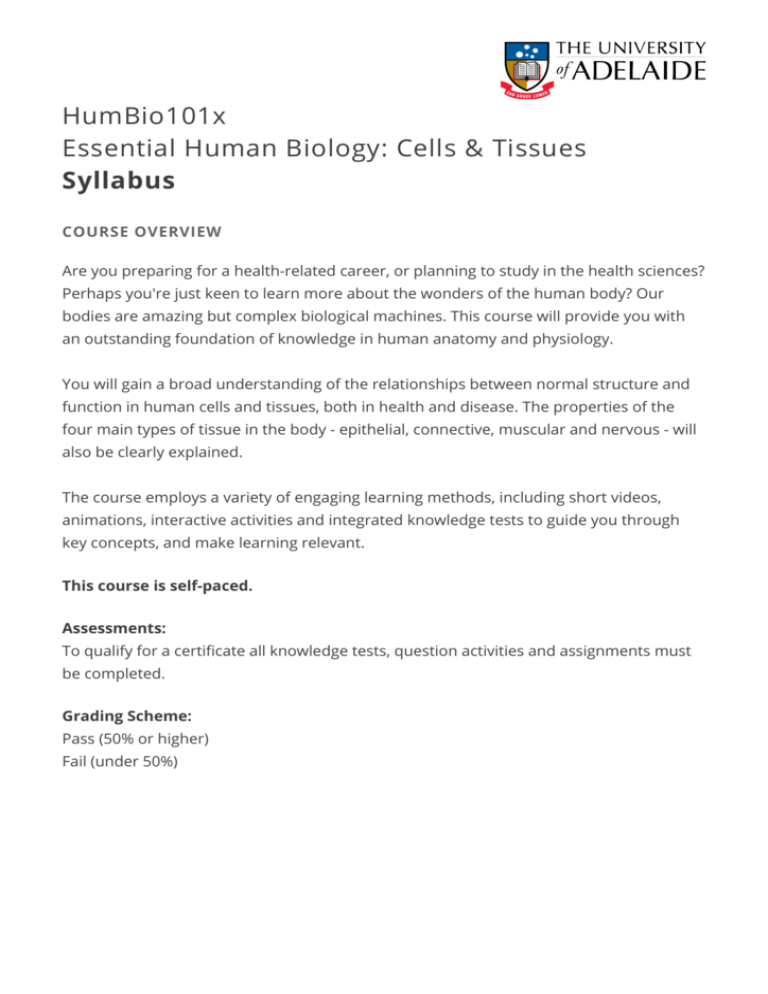
HumBio101x Essential Human Biology: Cells & Tissues Syllabus COURSE OVERVIEW Are you preparing for a health-related career, or planning to study in the health sciences? Perhaps you're just keen to learn more about the wonders of the human body? Our bodies are amazing but complex biological machines. This course will provide you with an outstanding foundation of knowledge in human anatomy and physiology. You will gain a broad understanding of the relationships between normal structure and function in human cells and tissues, both in health and disease. The properties of the four main types of tissue in the body - epithelial, connective, muscular and nervous - will also be clearly explained. The course employs a variety of engaging learning methods, including short videos, animations, interactive activities and integrated knowledge tests to guide you through key concepts, and make learning relevant. This course is self-paced. Assessments: To qualify for a certificate all knowledge tests, question activities and assignments must be completed. Grading Scheme: Pass (50% or higher) Fail (under 50%) WEEK 1: THE CELL ASSOCIATE PROFESSOR MARIO RICCI Week 1 Learning Objectives: • Identify the three main regions of a cell: plasma membrane, nucleus and cytoplasm. • Describe the structure of the plasma membrane. • Explain how molecules move across the plasma membrane. • Describe the structure and function of the main organelles of the cytoplasm. • Describe the structure and function of the nucleus and nuclear envelope. • Correlate the appearance of a nucleus to its function. • Describe the sequence of events in protein synthesis. Week 1 Assessment Requirements: You'll be assessed on the following items: • Lesson 1: Plasma Membrane Knowledge Test (5 Points) • Lesson 2: The Structure of the Cell Knowledge Test (5 Points) • Lesson 3: Nucleus Knowledge Test + Question Activity (6 + 6 = 12 Points) • Lesson 4: Protein Production Knowledge Test (6 Points) • Self Assessment Assignment on Cystic Fibrosis (28 Points) WEEK 2: EPITHELIAL TISSUE ASSOCIATE PROFESSOR RACHEL GIBSON Week 2 Learning Objectives: • Identify and characterise the four basic types of epithelial tissue in the body. • Describe the general features of epithelial tissue. • Describe the structural classification of epithelial tissue by layering and shape. • Describe the junctions that hold cells together. • Describe the typical appearance and function of glands. Week 2 Assessment Requirements: You'll be assessed on the following items: • Lesson 1: Characteristics & Functions of Epithelial Tissue Knowledge Test (5 Points) • Lesson 2: Classification of Epithelial Tissue Knowledge Test (5 Points) • Lesson 3: Epithelial Surface Features Knowledge Test + Question Activity (5 + 4 = 9 Points) • Lesson 4: Glands Knowledge Test (7 Points) • Self Assessment Assignment on Coeliac Disease (28 Points) WEEK 3: CONNECTIVE TISSUE SOPHIE KARANICOLAS Week 3 Learning Objectives: • Describe the characteristic features and functional properties of connective tissue. • Discuss the types of cells and fibres found in connective tissue. • Identify and characterise the three main types of connective tissue in the body: connective tissue proper, loose and dense, and specialised connective tissue. Week 3 Assessment Requirements: You'll be assessed on the following items: • Lesson 1: Characteristics & Functions of Connective Tissue Knowledge Test (5 Points) • Lesson 2: Loose & Dense Connective Tissue Knowledge Test + Question Activity (7 + 2 = 9 Points) • Lesson 3: Bone Tissue Knowledge Test (4 Points) • Lesson 4: Blood Tissue Knowledge Test (6 Points) • Self Assessment Assignment on Myeloma (28 Points) WEEK 4: MUSCULAR TISSUE CATHERINE SNELLING Week 4 Learning Objectives: • Describe the characteristic features and functional properties of muscle tissue. • Compare and contrast the three types of muscle tissue. • Describe the structural components of a skeletal muscle cell. • Describe the connective tissues associated with a skeletal muscle. • Describe the structure and function cardiac and smooth muscle cells. Week 4 Assessment Requirements: You'll be assessed on the following items: • Lesson 1: Characteristics & Types of Muscular Tissue Knowledge Test (5 Points) • Lesson 2: Skeletal Muscles Knowledge Test (5 Points) • Lesson 3: Connective Tissue of Skeletal Muscle Knowledge Test (4 Points) • Lesson 4: Cardiac & Smooth Muscle Knowledge Test (5 Points) • Self Assessment Assignment on Strains & Sprains (28 Points) WEEK 5: NERVOUS TISSUE DR FEMKE BUISMAN-PIJLMAN Week 5 Learning Objectives: • Identify the main functions of the nervous system. • Name the basic subdivisions of the nervous system. • Identify the main components of nervous tissue. • Identify the parts of a neuron and describe their functional roles. • Classify neurons by structure and function. • Describe the supporting cells in nervous tissue. Week 5 Assessment Requirements: You'll be assessed on the following items: • Lesson 1: Functions & Divisions of Nervous Tissue Knowledge Test (4 Points) • Lesson 2: Support Cells Knowledge Test (5 Points) • Lesson 3: Anatomy of the Neuron Knowledge Test + Question Activity (5 + 8 = 13 Points) • Lesson 4: Neuronal Communication and Brain Knowledge Test (5 Points) • Self Assessment Assignment on Traumatic Brain Injury (14 Points)

